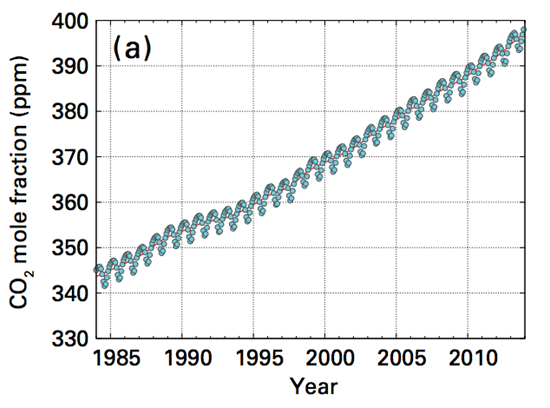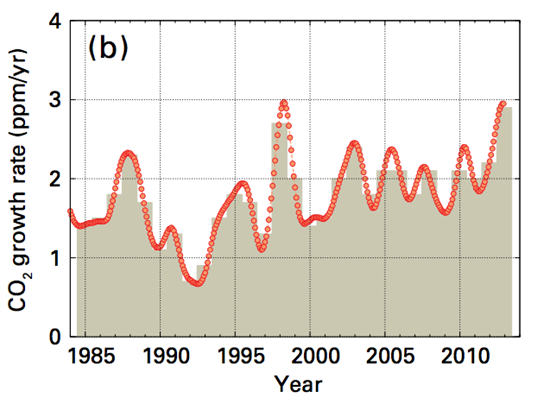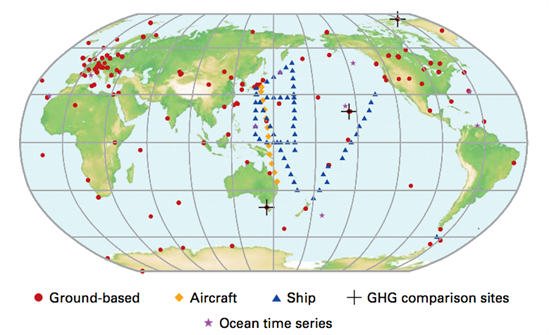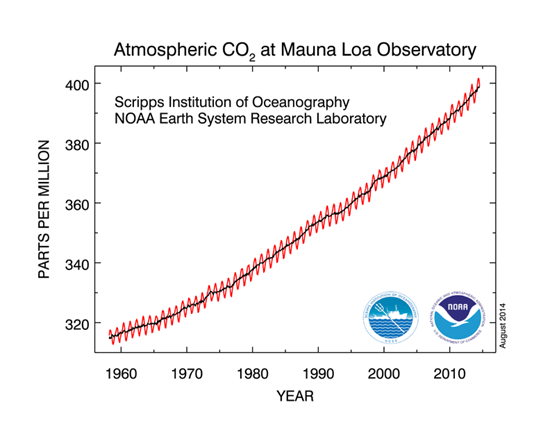Greenhouse gas levels in the atmosphere reached a record high in 2013, according to the latest measurements by the World Meteorological Organisation.
As announced in their annual Greenhouse Gas Bulletin, the amount of carbon dioxide in the atmosphere has reached 396 parts per million (ppm) – 42 per cent higher than pre-industrial levels.
Largest increase
The World Meteorological Organisation’s (WMO) measurements revealed an increase in global carbon dioxide concentrations from 2012 to 2013 of almost 3 ppm. This is larger than recent annual increases of around 2.1 ppm and the largest annual increase since 1984.
The steady increase in annual carbon dioxide over the past 30 years is shown in the upper graph below. These increases are primarily caused by burning fossil fuels such as oil, coal and gas, but cement production, deforestation and land use change also contribute.
The lower graph shows how the annual increase, or growth rate, has varied over the same period. It shows the peak in 2013 and also an earlier spike in growth rate in 1998, which was the result of widespread wildfires during a strong El Niño event.
(a) Globally-averaged carbon dioxide in ppm from 1984 to 2013; (b) Carbon dioxide growth rate from 1984 to 2013 (shaded columns show annual averages). WMO
For the first time, the WMO’s Bulletin also includes a report on ocean acidification. The world’s oceans absorb around a quarter of the carbon dioxide we produce, thus reducing how much reaches the atmosphere. However, the process increases the acidity of the water, which can make it more difficult for small marine creatures to form shells. These creatures are the foundation of ocean food webs, and so any impact on them has knock-on effects.
Warming effect
The WMO also reports on other important greenhouse gases. Methane in the atmosphere hit a new high last year, with levels of 1824 parts per billion (ppb) recorded – 153 per cent higher than pre-industrial levels. Nitrous oxide, meanwhile, increased to 326 ppb, which is 21 per cent higher than pre-industrial levels.
Carbon dioxide, methane and nitrous oxide are the most important greenhouse gases, and between them account for approximately 88 per cent of the warming effect of ‘long-lived’ greenhouse gases on our climate.
According to NOAA, the National Oceanic and Atmospheric Administration, if you add their concentrations to those of the more minor greenhouse gases, the total would be equivalent to 497 ppm of carbon dioxide.
NOAA reports that greenhouse gases caused an overall increase in the warming effect on the climate of 34 per cent between 1990 and 2013.
Mauna Loa
The WMO coordinates measurements of atmospheric greenhouse gases as part of its ‘Global Atmosphere Watch‘ programme. Measurements are taken from stations on land, and those aboard aircraft and ships, as shown in the map below.
WMO global network for carbon dioxide measurements. WMO
Regular monitoring of carbon dioxide was first set in 1958 up by Dr Charles Keeling. He established an observatory on an extinct mountain called Mauna Loa in Hawaii. With its remote location and undisturbed air, it formed an ideal place to measure the atmosphere.
Concentrations of carbon dioxide were around 315 ppm in that first year. As Keeling recorded the rise in carbon dioxide levels, he used them to construct the now iconic ‘Keeling Curve’, as shown below.
Monthly (red line) and annual (black line) average atmospheric carbon dioxide at Mauna Loa Observatory. NOAA
Keeling also noted the regular fluctuations of carbon dioxide within each year. Levels would peak in the northern hemisphere winter before falling to a low during the summer. The cause, he found, was seasonal plant growth.
The majority of the world’s vegetation is in the northern hemisphere – where there is more land. As plants grow in the spring and summer, they absorb carbon dioxide. When plants die and leaves are shed in the autumn and winter, this carbon dioxide is released back into the atmosphere. This annual fluctuation amounts to around 5 ppm per year.
Last week it was announced that the observatory had received a $500,000 grant from the Schmidt Family Foundation, which will fund another five years of measurements and allow scientists to address the backlog in samples that had yet to be analysed after a funding shortage.
In 2013, the Mauna Loa observatory recorded a carbon dioxide measurement of over 400 ppm for the first time in human history. As global emissions show no sign of abating, it may well be there to see many more records broken.





